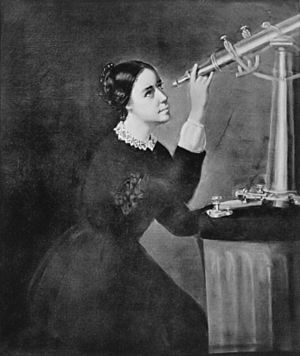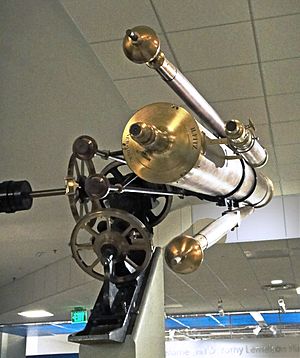Maria Mitchell facts for kids
Quick facts for kids
Maria Mitchell
|
|
|---|---|

Maria Mitchell, painting by Herminia Borchard Dassel, 1852
|
|
| Born | August 1, 1818 Nantucket, Massachusetts, U.S.
|
| Died | June 28, 1889 (aged 70) Lynn, Massachusetts, U.S.
|
| Known for |
|
| Awards | King of Denmark's Cometary Prize Medal, 1848 |
| Scientific career | |
| Fields | Astronomy |
| Institutions |
|
| Notable students | Margaretta Palmer |
| Signature | |
Maria Mitchell (born August 1, 1818 – died June 28, 1889) was an amazing American astronomer, librarian, and teacher. In 1847, she discovered a comet that was later called "Miss Mitchell's Comet" in her honor. She won a gold medal for this discovery from the King of Denmark in 1848.
Maria Mitchell was the first woman in America to become a professional astronomer and a professor of astronomy. She started teaching at Vassar College in 1865. She was also the first woman to be chosen as a member of important science groups like the American Academy of Arts and Sciences.
Contents
Early Life and Learning (1818–1846)
Maria Mitchell was born on August 1, 1818, in Nantucket, Massachusetts. Her mother, Lydia Coleman Mitchell, worked in a library. Her father, William Mitchell, was a schoolteacher and loved studying the stars.
Maria was one of ten children. Her family were Quakers, a religious group that believed strongly in education and hard work. Her father taught all his children about nature and the stars. Her mother's job at the library gave them access to many books and lots of knowledge.
Maria was especially good at astronomy and math. Her father taught her how to use different tools for looking at the sky. These included telescopes and other instruments. She often helped her father with his work, like observing the night sky.
Her parents believed that girls should have the same education as boys. This was not common at the time. Nantucket was a busy whaling port. Many women on the island had to manage their homes and lives while their husbands were away at sea. This helped create a feeling of independence for women there.
Maria went to a small school when she was very young. Then she attended the North Grammar school, where her father was the first principal. When she was 11, her father opened his own school. Maria was a student there and also helped him teach. At home, her father taught her astronomy using his own telescope. When she was 12, she even helped him figure out the exact time of a solar eclipse in 1831.
After her father's school closed, Maria went to a school for young ladies until she was 16. She then worked as a teaching assistant. In 1835, she opened her own school. Maria tried new ways of teaching. She made a brave choice to let non-white children attend her school. This was unusual because public schools were still separated by race back then.
In 1836, Maria became the first librarian at the Nantucket Atheneum. She worked there for 20 years. The library's hours allowed her to keep helping her father. They worked together on astronomical observations for the U.S. Coast Survey. They used a telescope on the roof of a bank building. They looked for new stars and calculated positions using the stars and moon.
Around 1843, Maria left the Quaker faith. She started following Unitarian ideas. She stayed close to her family, even though she changed her beliefs. We don't have many of her personal papers from before 1846. Her family believed she burned them to keep them private, after seeing other people's papers blown around during a big fire in Nantucket.
Discovering "Miss Mitchell's Comet" (1847–1849)

On the night of October 1, 1847, at 10:50 pm, Maria Mitchell discovered a new comet. She used a special telescope. She noticed an unknown object in the sky where she hadn't seen anything before. She was sure it was a comet. This comet later became known as "Miss Mitchell's Comet."
She announced her discovery in a science journal in January 1848. The next month, she shared her calculations of the comet's path. This proved she was the first to find it. She was celebrated for her discovery later that year.
On October 6, 1848, Maria Mitchell received a gold medal for her discovery. It was from King Christian VIII of Denmark. This award was for the first person to discover a new comet that could only be seen with a telescope. Another astronomer, Francesco de Vico, had also found the same comet two days after Maria. But Maria had reported it first. So, the prize was given to her.
The medal had a Latin saying on it: "Not in vain do we watch the setting and the rising [of the stars]." Before Maria, only two other women astronomers had discovered comets. Maria received the medal in Nantucket in March 1849. She was the first American to win this medal and the first woman to receive an award in astronomy.
Busy Years (1849–1864)
After her discovery and awards, Maria Mitchell became very famous. Hundreds of newspaper articles were written about her. At her home in Nantucket, she met many important thinkers of her time. These included Ralph Waldo Emerson and Frederick Douglass.
In 1849, Maria took a job with the U.S. Coast Survey. She worked at the Nautical Almanac Office. Her job was to track the movements of planets, especially Venus. She made tables of their positions to help sailors navigate their ships. In 1850, she joined the American Association for the Advancement of Science. She became friends with many members, including Joseph Henry, who directed the Smithsonian Institution.
In 1857, Maria traveled to Europe. She visited observatories and met famous astronomers like John Herschel. She also talked with many other scientists. She traveled with the writer Nathaniel Hawthorne and his family. Maria never married. She stayed very close to her family throughout her life.
Teaching at Vassar College (1865–1888)
Even though Maria Mitchell did not go to college herself, she was asked to be a professor of astronomy at Vassar College in 1865. The college's founder, Matthew Vassar, hired her. She became the first female professor of astronomy.
Maria was the very first person hired for the college's faculty. She was also made the director of the Vassar College Observatory. She held this job for over 20 years. Maria also wrote for the astronomy section of Scientific American magazine. Because of Maria's excellent teaching, Vassar College had more students studying math and astronomy than Harvard University for many years. In 1869, she became one of the first women elected to the American Philosophical Society. She also received honorary degrees from other colleges.
Maria kept many of her unique teaching methods in her classes. She didn't give grades or take attendance. She preferred small classes and giving each student special attention. She also used technology and math in her lessons. She knew that her students might not become professional astronomers. But she believed studying astronomy would help them think clearly. She once told her students, "When we are bothered by small worries, a look at the stars will show us how small our own problems are."
Maria's own research was very varied. She took pictures of planets like Jupiter and Saturn and their moons. She also studied nebulae, double stars, and solar eclipses. Maria developed her own ideas from her observations. For example, she thought about how stars orbit each other in double star systems. She also studied how distance and what stars are made of affect their color.
Maria often included her students in her observations. They worked both in the field and at the Vassar College Observatory. She started observing sunspots by eye in 1868. Then, in 1873, she and her students began photographing them every day. These were the first regular photographs of the sun. They helped her explore the idea that sunspots were like holes on the sun's surface, not clouds. For the total solar eclipse of July 29, 1878, Maria and five assistants traveled to Denver with a telescope to observe it. Her efforts helped many of her students succeed in science. Twenty-five of her students were later listed in Who's Who in America.
After teaching at Vassar for some time, Maria found out that her salary was less than that of younger male professors. This was despite her fame and experience. Maria and Alida Avery, the only other woman on the faculty, demanded a pay raise. They got it! She taught at Vassar College until she retired in 1888, one year before she passed away.
Working for Social Change
In 1841, Maria attended an anti-slavery meeting in Nantucket. This is where Frederick Douglass gave his first speech. She also joined the anti-slavery movement by refusing to wear clothes made from cotton grown in the Southern states.
Later, as a professor, she became involved in many social issues. She cared especially about women's suffrage (the right for women to vote) and education for women. She became friends with leaders like Elizabeth Cady Stanton.
After a trip to Europe in 1873, Maria joined the national women's movement. She helped start the Association for the Advancement of Women (AAW). This group worked to improve education and support women in higher learning. Maria gave a speech to the AAW called The Higher Education of Women. In it, she talked about how English women were working to get into colleges like Girton College, Cambridge. Maria believed women should work part-time while studying. This would help them pay for their education and empower more women to join the workforce. She also spoke about the importance of women in science and math. She encouraged people to support women's colleges and women running for local school boards. Maria was the second president of the AAW in 1875 and 1876. Then she stepped down to lead a special Committee on Science. This committee worked to study and promote women's progress in science. She held this position until her death in 1889.
Death and Lasting Impact

Maria Mitchell passed away from a brain disease on June 28, 1889. She was 70 years old. She was buried in Nantucket.
An organization called the Maria Mitchell Association was created in Nantucket. It works to promote science on the island and honor Maria Mitchell's work. The Association runs a Natural History museum, an Aquarium, a Science Library, Maria Mitchell's Home Museum, and an Observatory named after her.
Maria Mitchell was honored during National Women's History Month in 1989. She was also added to the National Women's Hall of Fame in 1994. A World War II ship was named the SS Maria Mitchell after her. A train on New York's Metro-North Railroad is called the Maria Mitchell Comet. A crater on the moon was also named in her honor. On August 1, 2013, the search engine Google celebrated Maria Mitchell with a special Google Doodle. It showed her looking through a telescope on a roof, searching for comets.
Maria Mitchell's special place in American science and culture has been shown in many recent books and articles.
See also
 In Spanish: Maria Mitchell para niños
In Spanish: Maria Mitchell para niños
Images for kids


